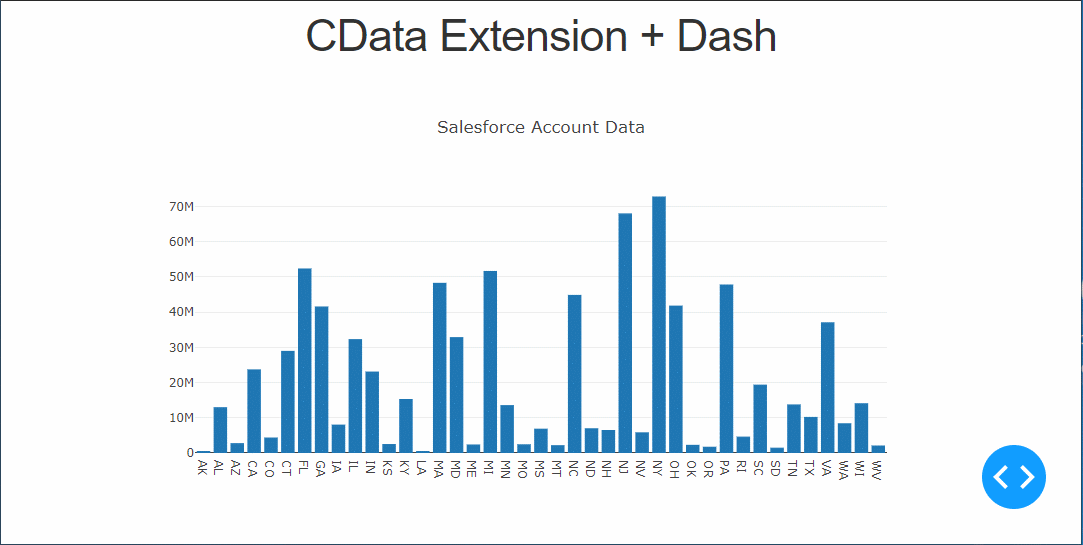Discover how a bimodal integration strategy can address the major data management challenges facing your organization today.
Get the Report →Use Dash to Build to Web Apps on REST Data
Create Python applications that use pandas and Dash to build REST-connected web apps.
The rich ecosystem of Python modules lets you get to work quickly and integrate your systems more effectively. With the CData Python Connector for REST, the pandas module, and the Dash framework, you can build REST-connected web applications for REST data. This article shows how to connect to REST with the CData Connector and use pandas and Dash to build a simple web app for visualizing REST data.
With built-in, optimized data processing, the CData Python Connector offers unmatched performance for interacting with live REST data in Python. When you issue complex SQL queries from REST, the driver pushes supported SQL operations, like filters and aggregations, directly to REST and utilizes the embedded SQL engine to process unsupported operations client-side (often SQL functions and JOIN operations).
Connecting to REST Data
Connecting to REST data looks just like connecting to any relational data source. Create a connection string using the required connection properties. For this article, you will pass the connection string as a parameter to the create_engine function.
See the Getting Started chapter in the data provider documentation to authenticate to your data source: The data provider models REST APIs as bidirectional database tables and XML/JSON files as read-only views (local files, files stored on popular cloud services, and FTP servers). The major authentication schemes are supported, including HTTP Basic, Digest, NTLM, OAuth, and FTP. See the Getting Started chapter in the data provider documentation for authentication guides.
After setting the URI and providing any authentication values, set Format to "XML" or "JSON" and set DataModel to more closely match the data representation to the structure of your data.
The DataModel property is the controlling property over how your data is represented into tables and toggles the following basic configurations.
- Document (default): Model a top-level, document view of your REST data. The data provider returns nested elements as aggregates of data.
- FlattenedDocuments: Implicitly join nested documents and their parents into a single table.
- Relational: Return individual, related tables from hierarchical data. The tables contain a primary key and a foreign key that links to the parent document.
See the Modeling REST Data chapter for more information on configuring the relational representation. You will also find the sample data used in the following examples. The data includes entries for people, the cars they own, and various maintenance services performed on those cars.
After installing the CData REST Connector, follow the procedure below to install the other required modules and start accessing REST through Python objects.
Install Required Modules
Use the pip utility to install the required modules and frameworks:
pip install pandas pip install dash pip install dash-daq
Visualize REST Data in Python
Once the required modules and frameworks are installed, we are ready to build our web app. Code snippets follow, but the full source code is available at the end of the article.
First, be sure to import the modules (including the CData Connector) with the following:
import os import dash import dash_core_components as dcc import dash_html_components as html import pandas as pd import cdata.rest as mod import plotly.graph_objs as go
You can now connect with a connection string. Use the connect function for the CData REST Connector to create a connection for working with REST data.
cnxn = mod.connect("DataModel=Relational;URI=C:/people.xml;Format=XML;")
Execute SQL to REST
Use the read_sql function from pandas to execute any SQL statement and store the result set in a DataFrame.
df = pd.read_sql("SELECT [ personal.name.first ], [ personal.name.last ] FROM people WHERE [ personal.name.last ] = 'Roberts'", cnxn)
Configure the Web App
With the query results stored in a DataFrame, we can begin configuring the web app, assigning a name, stylesheet, and title.
app_name = 'dash-restedataplot' external_stylesheets = ['https://codepen.io/chriddyp/pen/bWLwgP.css'] app = dash.Dash(__name__, external_stylesheets=external_stylesheets) app.title = 'CData + Dash'
Configure the Layout
The next step is to create a bar graph based on our REST data and configure the app layout.
trace = go.Bar(x=df.[ personal.name.first ], y=df.[ personal.name.last ], name='[ personal.name.first ]')
app.layout = html.Div(children=[html.H1("CData Extension + Dash", style={'textAlign': 'center'}),
dcc.Graph(
id='example-graph',
figure={
'data': [trace],
'layout':
go.Layout(title='REST people Data', barmode='stack')
})
], className="container")
Set the App to Run
With the connection, app, and layout configured, we are ready to run the app. The last lines of Python code follow.
if __name__ == '__main__':
app.run_server(debug=True)
Now, use Python to run the web app and a browser to view the REST data.
python rest-dash.py

Free Trial & More Information
Download a free, 30-day trial of the CData Python Connector for REST to start building Python apps with connectivity to REST data. Reach out to our Support Team if you have any questions.
Full Source Code
import os
import dash
import dash_core_components as dcc
import dash_html_components as html
import pandas as pd
import cdata.rest as mod
import plotly.graph_objs as go
cnxn = mod.connect("DataModel=Relational;URI=C:/people.xml;Format=XML;")
df = pd.read_sql("SELECT [ personal.name.first ], [ personal.name.last ] FROM people WHERE [ personal.name.last ] = 'Roberts'", cnxn)
app_name = 'dash-restdataplot'
external_stylesheets = ['https://codepen.io/chriddyp/pen/bWLwgP.css']
app = dash.Dash(__name__, external_stylesheets=external_stylesheets)
app.title = 'CData + Dash'
trace = go.Bar(x=df.[ personal.name.first ], y=df.[ personal.name.last ], name='[ personal.name.first ]')
app.layout = html.Div(children=[html.H1("CData Extension + Dash", style={'textAlign': 'center'}),
dcc.Graph(
id='example-graph',
figure={
'data': [trace],
'layout':
go.Layout(title='REST people Data', barmode='stack')
})
], className="container")
if __name__ == '__main__':
app.run_server(debug=True)






